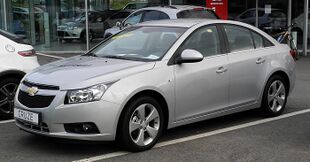Engineering:General Motors Delta platform
| GM Delta platform | |
|---|---|
 | |
| Overview | |
| Manufacturer | General Motors |
| Production | 2002–present |
| Body and chassis | |
| Class | Compact (C) |
| Body style(s) | 2-door coupe 2-door convertible 3-door hatchback 4-door sedan 4-door SUV 5-door hatchback |
| Chronology | |
| Predecessor | GM J platform GM R platform GM T platform GM Z platform |
| Successor | For Opel & Vauxhall: PSA EMP2 platform For GM: GM VSS-F |
Delta was a General Motors compact front-wheel drive automobile and crossover SUV platform, originally developed by Opel Group. Delta was a successor to the Opel T platform; it also replaced J platform and the Z platform used by the Saturn S-Series. The platform debuted in the 2003 Saturn Ion. Vehicles of this platform generally carry the letter "A" in the fourth character of their VINs.
Delta uses an independent suspension in front and Twist beam type in the rear. The Ecotec engine is widely used, as are a 4-speed automatic and 5-speed manual transmission.
Delta
Applications
Former vehicles based on this platform:
- 2003–2007 Saturn Ion
- 2005–2010 Chevrolet Cobalt
- 2005–2009 Pontiac G5/G4/Pursuit
- 2006–2011 Chevrolet HHR
Delta II
Delta II was General Motors' global compact car platform, developed by Opel in Germany. It was the successor to the GM Delta platform. Internally it is simply known as a new Global Compact Vehicle Architecture or GCV.
The platform features a torsion beam (marketed as compound crank) rear suspension with optional Watt's link which improves vehicle handling; such configuration is used with the Opel Astra, Buick Verano, Cadillac ELR, Opel Cascada and higher trim-levels of the American-market Chevrolet Cruze.
This suspension is usually described as semi-independent, meaning that the two wheels can move relative to each other, but their motion is still somewhat inter-linked, to a greater extent than in a true independent rear suspension (IRS). This can mildly compromise the handling and ride quality of the vehicle. For this reason, some manufacturers have changed to different linkage designs. As an example, Volkswagen dropped the torsion beam in favour of a true IRS for the Volkswagen Golf Mk5, possibly in response to the Ford Focus' Control Blade rear suspension.
As noted, certain GM brands and models have continued to use the suspension setup, known variously as twist beam, torsion beam or compound crank suspension. This is at a cost saving of €100 per car compared to multi-link rear suspension.[1] The version used on the 2009-on Opel Astra and the 2011-2016 Buick Verano uses a Watts linkage at a cost of €20 to address the drawbacks and provide a competitive and cost effective rear suspension.[1] The Renault Mégane and Citroen C4 also have stayed with the twist beam.[2] The twist beam has been shown to suffer less from bush wear, than fully independent multi-link suspension, thus resulting in a virtually maintenance free rear suspension.
GM chose this compact vehicle architecture for its first Voltec application, the Chevrolet Volt. Production began in November 2010 with the first Chevrolet Volts delivered to retails customers in December 2010.[3]
Applications
Production vehicles based on Delta II platform:
- 2008–2016 Chevrolet Cruze, Daewoo Lacetti Premiere, Holden Cruze[4]
- 2009–2015 Opel Astra J, Buick Excelle XT
- 2010–2015 Chevrolet Volt
- 2010–2018 Chevrolet Orlando
- 2011–2016 Buick Verano
- 2011–2015 Opel Ampera
- 2011–2019 Opel Zafira Tourer C
- 2013–2016 Cadillac ELR[5][failed verification][6][failed verification]
- 2013–2019 Opel Cascada (also marketed as Vauxhall Cascada, Holden Cascada, Buick Cascada and Opel Cabrio)
- 2017–present Chevrolet Cavalier
D2XX/D2UX
General Motors introduced its new global platform named D2XX flexible platform in August 2012. The new platform was mainly engineered by GM's former German subsidiary Opel in Rüsselsheim.[7] According to GM the company invested US$220 million for the all new D2XX platform.[citation needed]
The platform was developed for compact vehicle architecture, replacing both Delta II and the midsize crossover GM Theta platform.[8]
Vehicles that use the new platform included:
- 2015–2023 Chevrolet Cruze
- 2015–2022 Opel Astra K
- 2016–2019 Chevrolet Volt[9]
- 2018–present Chevrolet Equinox
- 2018–present GMC Terrain
- 2019–present Chevrolet Orlando
GM-PATAC K
In 2015 Pan Asia Technical Automotive Center (PATAC), GM's joint development center with SAIC, revealed their own simplified variant of D2XX, known as the "GM-PATAC K" platform (rather than "K" so as to distinguish it from the former GM K platforms).[10] The following vehicles use this variant of the platform, none of which are sold in the United States:
- 2015–present Buick Excelle GT
- 2016–present Chevrolet Cavalier
- 2017–2023 Buick GL6
- 2019–present Chevrolet Monza
- 2017-present Roewe i5/ Ei5
References
- ↑ 1.0 1.1 Richard Aucock (January 22, 2010). "Astra suspension by Automotive Engineer". http://www.richardaucock.com/astra-suspension-by-automotive-engineer/.
- ↑ Simon Bickerstaffe (December 1, 2010). "Vehicle dynamics & chassis: A new leaf". http://ae-plus.com/focus/vehicle-dynamics-and-chassis-a-new-leaf.
- ↑ "NEW 2011 Chevy Volt - Gearhart Chevrolet Delivers First Volt in America". December 16, 2010. http://wn.com/NEW_2011_Chevy_Volt__Gearhart_Chevrolet_Delivers_First_Volt_in_America.
- ↑ "Paris debut for new Chevrolet Cruze sedan - paultan.org" (in en-US). 2008-07-10. https://paultan.org/2008/07/10/paris-debut-for-new-chevrolet-cruze-sedan/.
- ↑ "GM to produce Cadillac Converj with Volt's plug-in technology" (Automotive Week) January 11, 2010
- ↑ "GM Will Produce Volt-Based Cadillac Converj Plug-in Concept" (Motor Trend) January 11, 2010
- ↑ https://www.cnbc.com/id/101041918
- ↑ "GM's D2XX Platform Detailed". 28 August 2012. http://www.autoevolution.com/news/gms-d2xx-platform-detailed-48772.html.
- ↑ "2016 Chevrolet Volt Unveiled: More range, passenger room (+VIDEO)". 12 January 2015. http://www.kbb.com/car-news/all-the-latest/2016-chevrolet-volt-unveiled-more-range-passenger-room/2000011569/.
- ↑ "New Details About All-New Chevrolet Monza Sedan Emerge". 23 January 2019. https://gmauthority.com/blog/2019/01/new-details-about-all-new-chevrolet-monza-sedan-emerge/.
External links
- GM Delta Enthusiasts (a part of the GM Enthusiast Network)
- "Chevy gets new compact car next year". Automotive News (2008-06-01)
 |














































